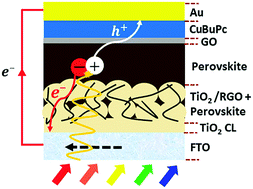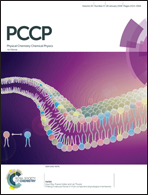Improvement of the photovoltaic parameters of perovskite solar cells using a reduced-graphene-oxide-modified titania layer and soluble copper phthalocyanine as a hole transporter†
Abstract
Functional perovskite solar cells can be made by using a simple, inexpensive and stable soluble tetra-n-butyl-substituted copper phthalocyanine (CuBuPc) as a hole transporter. In the present study, TiO2/reduced graphene oxide (T/RGO) hybrids were synthesized via an in situ solvothermal process and used as electron acceptor/transport mediators in mesoscopic perovskite solar cells based on soluble CuBuPc as a hole transporter and on graphene oxide (GO) as a buffer layer. The impact of the RGO content on the optoelectronic properties of T/RGO hybrids and on the solar cell performance was studied, suggesting improved electron transport characteristics and photovoltaic parameters. An enhanced electron lifetime and recombination resistance led to an increase in the short circuit current density, open circuit voltage and fill factor. The device based on a T/RGO mesoporous layer with an optimal RGO content of 0.2 wt% showed 22% higher photoconversion efficiency and higher stability compared with pristine TiO2-based devices.

- This article is part of the themed collection: 2018 PCCP HOT Articles


 Please wait while we load your content...
Please wait while we load your content...